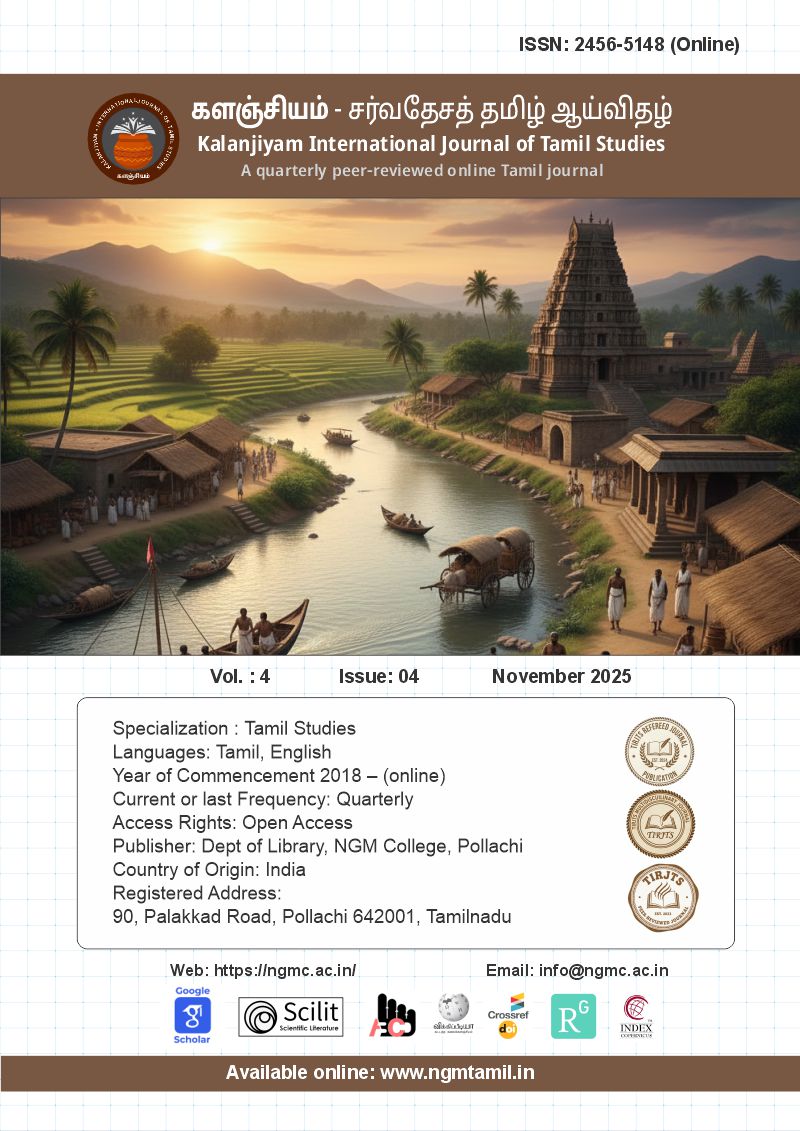செவிலித்தாயின் மெய்ப்பாட்டுணர்வுகள்
The Emotional Resonance of the Foster Mother (Sevili) in Classical Tamil Literature
DOI:
https://doi.org/10.63300/kirjts0404202505Keywords:
செவிலி, தலைவி, உடன்போக்கு, நற்றாய், தோழி, தொல்காப்பியம், கூற்று, செவிலி அழுகை, செவிலி உவகை, செவிலி நகைAbstract
The foster mother (Ceviliththai) occupies a unique and significant position within classical Tamil Sangam Akam literature. Transcending the status of a mere servant, she is depicted as an integrated and essential member of the family, responsible for nurturing the heroine (Thalaivi) from birth with profound love and unwavering duty. As established by Tolkappiyam, her role is often doubly significant as the mother of the heroine’s companion (Thozhi), thereby establishing deep, interconnected kinship bonds between the Thalaivi, the Thozhi, and the biological mother (Nattray). This article centers on the emotional landscape of the Ceviliththai during a moment of profound crisis: her discovery of the heroine’s elopement (Udanpokku). Drawing extensively upon rules outlined in Tolkappiyam and poetic evidence from various Sangam anthologies, this study investigates the intense psychological distress and emotional turbulence experienced by the Ceviliththai. The primary objective is to meticulously examine the specific contexts and diverse forms—be they expressions of grief, deep maternal devotion, or profound anxiety over the heroine's future—in which she articulates her inner turmoil. The analysis illuminates the psychological dimensions, the particular settings that prompt her utterances (Ceviliththai Kuttu), and the crucial social reflections inherent in the Ceviliththai’s duty-bound and emotionally powerful voice, firmly establishing her role as the emotional and moral compass of the domestic space in Akam poetry.
சங்க அக இலக்கியங்களில் தலைவியின் வளர்ப்புத் தாயாக, பிறப்பு முதல் அன்புடன் போற்றி வளர்ப்பவளாக, குடும்பத்தின் மேலான நிலையிலிருந்து கடமையுணர்வோடும், பாசத்தோடும் செயல்படும் செவிலித்தாயின் பாத்திரம் தனிச்சிறப்பு வாய்ந்தது. பொருளிற்காகப் பணி செய்யும் பணிப் பெண் என்பதைத் தாண்டி, குடும்பத்தின் ஓர் அங்கமாகவே அவர் போற்றப்படுகிறார். தொல்காப்பியம் குறிப்பிடுவதுபோல், தலைவியின் தோழியின் தாயாகவும் செவிலி இருப்பதால், தலைவி-தோழி, நற்றாய்-செவிலி ஆகியோரிடையே ஆழமான, பிணைப்புடைய உறவு வெளிப்படுகிறது. இத்தகைய நெருக்கமான சமூகப் பின்னணியில், தலைவியின் மீது செவிலித்தாய் கொண்டிருக்கும் அன்பு, கடமை உணர்வு, மற்றும் உறவின் முக்கியத்துவம் மையப்படுத்தப்படுகிறது. இக்கட்டுரை, தலைவியின் உடன்போக்கினை அறிந்த செவிலித்தாயின் மன உளைச்சலையும், உணர்ச்சிப் பெருக்கையும் ஆராய்கிறது. தலைவியின் பிரிவினால் துயருறும் செவிலித்தாய், தன் வருத்தத்தையும், தலைவியின் மீதான பாசத்தையும், எதிர்காலம் குறித்த கவலைகளையும் எந்தெந்தச் சூழல்களில், எவ்வாறெல்லாம் வெளிப்படுத்துகிறாள் என்பதைத் தொல்காப்பியம் மற்றும் சங்க இலக்கியங்களின் துணையுடன் விரிவாக ஆய்வதே இக்கட்டுரையின் நோக்கம். செவிலியின் கூற்று நிகழும் இடங்கள், அதன் உளவியல் பரிமாணங்கள், மற்றும் சமூகப் பிரதிபலிப்புகள் ஆகியவை இக்கட்டுரையில் விளக்கப்படும்.
Downloads
References
1. Ravichandran, T. K. Freud, Jung, Lacan: An Introduction and Guide. p. 81. (Note: Publisher and year are not provided in the original source.)
2. Coleman, James C. Psychology and Effective Behavior. p. 175. (Note: Publisher and year are not provided in the original source.)
3. Ravichandran, T. K. Tolkappiyam and Freudianism. p. 123. (Note: Publisher and year are not provided in the original source.)
4. Pillai, Auvai Duraisamy. Ainkurunuru: Text and Commentary. Saradha Publishers, 2006.
5. Nattar, N. M. Vengadasamy. Akananuru: Text and Commentary. Gowra Publishers, 2019.
1. இரவிச்சந்திரன்.தி.கு., ஃப்ராய்ட், யூங், லக்கான் அறிமுகமும் நெறிமுகமும்., ப-81
2. James c coleman., psychology and Effective Behavior.,P-175.
3. இரவிச்சந்திரன்.தி.கு., தொல்காப்பியமும் ஃப்ராய்டியமும்., ப -123
4. ஒளவை. துரைசாமிப்பிள்ளை, ஐங்குறுநூறு மூலமும் உரையும், சாரதா பதிப்பகம்,
முதற்பதிப்பு -2006.
5. ந.மு.வேங்காடசாமி நாட்டார், அகநானூறு மூலமும் உரையும், கௌராபதிப்பகம்,
முதற்பதிப்பு – 2019.
Downloads
Published
Issue
Section
License

This work is licensed under a Creative Commons Attribution 4.0 International License.
Our journal adopts CC BY License Creative Commons Attribution 4.0 International License http://Creativecommons.org//license/by/4.0/ . It allows using, reusing, distributing and reproducing of the original work with proper citation.






